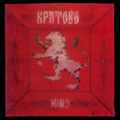
The flag of North Macedonia is the national flag of the Republic of North Macedonia and depicts a stylized yellow sun on a red field, with eight broadening rays extending from the center to the edge of the field. It was created by Miroslav Grčev and was adopted on 5 October 1995.

The coat of arms of Bulgaria consists of a crowned golden lion rampant over a dark red shield; above the shield is the Bulgarian historical crown. The shield is supported by two crowned golden lions rampant; below the shield there is compartment in the shape of oak twigs and white bands with the national motto "Unity makes strength" inscribed on them.

The Internal Macedonian Revolutionary Organization, was a secret revolutionary society founded in the Ottoman territories in Europe, that operated in the late 19th and early 20th centuries.

The Ilinden–Preobrazhenie Uprising, or simply the Ilinden Uprising of August–October 1903, was organized revolt against the Ottoman Empire, which was prepared and carried out by the Internal Macedonian-Adrianople Revolutionary Organization, with the support of the Supreme Macedonian-Adrianople Committee, which included mostly Bulgarian military personnel. The name of the uprising refers to Ilinden, a name for Elijah's day, and to Preobrazhenie which means Feast of the Transfiguration. Some historians describe the rebellion in the Serres revolutionary district as a separate uprising, calling it the Krastovden Uprising, because on September 14 the revolutionaries there also rebelled. The revolt lasted from the beginning of August to the end of October and covered a vast territory from the western Black Sea coast in the east to the shores of Lake Ohrid in the west.

The coat of arms of Togo was adopted on 14 March 1962. Since this Togolese national symbol does not follows the rules of heraldry for a traditional coat of arms, then it could be considered a national emblem instead.

Socialist-style emblems usually follow a unique style consisting of communist symbolism. Although commonly referred to as coats of arms, most are not actually traditional heraldic achievements. Many communist governments purposely diverged from heraldic tradition in order to distance themselves from the monarchies that they usually replaced, with coats of arms being seen as symbols of the monarchs.

The Supreme Macedonian-Adrianople Committee (SMAC),, also known as the Supreme Macedonian Committee was a Bulgarian paramilitary and political organization, active in Bulgaria as well as in Macedonia and Thrace regions of the Ottoman Empire. It was based in Bulgaria from 1895 to 1905. Macedonian Bulgarian and Thracian Bulgarian emigrants in Bulgaria, led by Trayko Kitanchev, formed in 1895 the Macedonian-Adrianople Organization, at the head of which was the Supreme Macedonian-Adrianople Revolutionary Committee. Its official aim was achieving autonomy for the Macedonia and Adrianople regions. At the same time, being impatient for the liberty to come sooner, and strongly convinced that it would come only with the help of the Bulgarian Army. Later they directed their efforts in activities for involving the country into war with the Ottoman Empire as for example during the Supreme Macedonian Committee chetas' action in 1895, and the Gorna Dzhumaya Uprising in 1902. As a rule its leaders were members of the Bulgarian Officers' Brotherhoods and had strong connections with the governments. At the end their main idea was, waging struggle for a direct unification with Bulgaria.
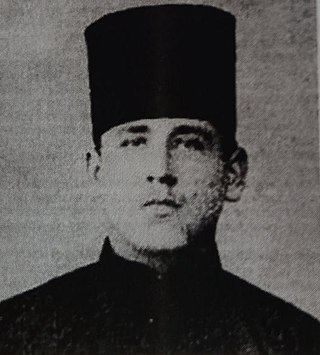
Mile Popyordanov, born Milan Popyordanov, was a Macedonian Bulgarian revolutionary and member of the Internal Macedonian-Adrianople Revolutionary Organization (IMARO). He is considered a Macedonian by the historians in North Macedonia.

Konstantin Antonov Ivanov, nicknamed Sechenkata, and also known under the name Valcho Antonov, was a Bulgarian revolutionary, a member of the Supreme Macedonian-Adrianople Committee, the Internal Macedonian-Adrianople Revolutionary Organization (IMARO) and the Bulgarian Communist Party.
The national symbols of North Macedonia, as stated in the constitution, are the coat of arms, the flag and the anthem. After the independence of North Macedonia from Yugoslavia, the country made some changes in the national symbols. The flag was changed two times and today's flag includes an eight-ray sun on a red background, while the coat of arms from the Socialist Republic of Macedonia was retained, except the red star which was removed.
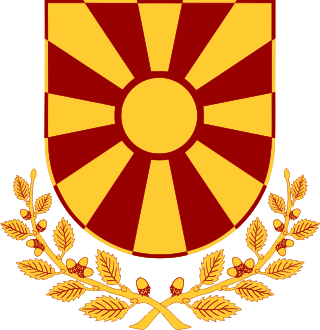
The coat of arms of the President of the Republic of North Macedonia is the official coat of arms of the President of North Macedonia. It was adopted on 2 December 2009, designed by the Macedonian Heraldry Society earlier that year, having been registered by the society on 10 June.

The national emblem of North Macedonia depicts two curved garlands of sheaves of wheat, tobacco leaves and opium poppy fruits, tied by a ribbon decorated with embroidery of traditional Macedonian folk motifs. In the center of the ovoid frame are depicted a mountain, a lake and a sunrise. The features of the national coat of arms contain a rising sun which symbolizes freedom, the Šar Mountains with its peak named Ljuboten or Mount Korab and the river Vardar, with Lake Ohrid. The emblem also contains opium poppy fruits; this poppy was brought to the area during Ottoman times in the first half of the 19th century. Until 16 November 2009, the emblem also depicted a socialistic five-pointed star in the top. This emblem had been in use since 1946, shortly after the republic became part of Yugoslavia.

Lazar Poptraykov was a Macedonian Bulgarian revolutionary (komitadji). He was also a Bulgarian Exarchate teacher and poet from Ottoman Macedonia. He was one of the leaders of the Internal Macedonian-Adrianople Revolutionary Organization (IMARO) in the region of Kastoria (Kostur) during the Ilinden Uprising. Despite his Bulgarian identification, per the post-WWII Macedonian historiography he was as an ethnic Macedonian.

Dzole Stoychev Gergev also known as Atesh Pasha, was a Macedonian Bulgarian revolutionary and freedom fighter, member of the Internal Macedonian-Adrianople Revolutionary Organization (IMARO)
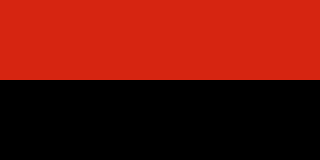
The official flag of the Internal Macedonian Revolutionary Organization was adopted in the early 1920s by the Central Committee of IMRO. In 1922, an article was issued by the member of the Macedonian Federative Organization Trifon Grekov entitled "The Flag of Independent Macedonia". It was published in the Bulgarian newspaper "Autonomous Macedonia", and proposed this flag to become the flag of the future Independent Macedonia. The flag was also the state flag of the proposed puppet state: Independent State of Macedonia. Today the flag is used by right wing political parties in North Macedonia like VMRO-DPMNE and also Bulgarian political parties like VMRO-BND.

Petar (Pere) Naumov Toshev was a Bulgarian teacher and an activist of the Internal Macedonian-Adrianople Revolutionary Organization. In the historiography in North Macedonia he is considered an ethnic Macedonian revolutionary.

The coat of arms of Marseille has witnessed its existence since the 14th century. The current version was adopted in 1883.

Svoboda ili smart, written in pre-1945 Bulgarian orthography: "Свобода или смърть" and before 1899: "Свобода или смъртъ", was a revolutionary slogan used during the national-liberation struggles by the Bulgarian revolutionaries, called comitadjis. The slogan was in use during the second half of the 19th and the first half of the 20th centuries.
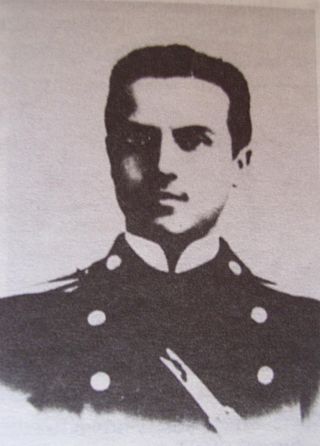
Milan Trajkov Stoilov was a socialist revolutionary from the region of Macedonia. According to Macedonian historians, he was a Macedonian activist. However according to Bulgarian historians, he is regarded as a Bulgarian revolutionary.

Rizo Rizov was a revolutionary from Veles and a participant in the Macedonian revolutionary movement. He was a member of the Internal Macedonian Adrianople Revolutionary Organization, fought for the independence of Macedonia and was one of the founders of the People's Federative Party and IMRO (United).











